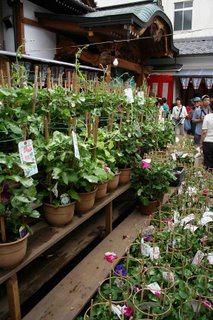According to a brochure, morning glory flower was carried down as a drug by a Japanese envoy to China in the Tang Dynasty. Growing morning glory flowers for visual effect became booming during Edo period. In Meiji era, Iriya became famous for morning glory and the flowers were displayed and sold, but all the gardeners closed a business by the beginning of Taisho Era. The fair revived after the War.
Popular is “Danjuro”, whose color is the same as that of the famous Kabuki actor, Danjuro Ichikawa. I bought one pot having four kinds of colors. It costs 2,000 yen. I felt rather expensive. I selected a stall which uses eco-friendly pots. I will be able to enjoy the flowers till the beginning of November.
(Precinct of Shingenji Temple)
(Sellers' Own Costumes)
(I Will Help to Water Flowers.)
*The pure Danjuro seems to have no while edging.





1 comment:
Summary in Japanese (日本語要約)
【夏の風物詩、朝顔市】
日本の小学校ではどの子も朝顔の栽培の経験をする。上野の近く、東京下町の入谷では、夏の風物詩のひとつ朝顔市が今日始まった。狭い歩道と真源寺の境内には50以上の露店が並べられた。
パンフレットによると、朝顔は、薬として遣唐使によって伝えられたそうだ。観賞用の朝顔の栽培は江戸時代に盛んになった。明治になると、入谷は、朝顔で有名になり、朝顔の花が陳列されたり販売されたが、大正の初めまでには、植木屋さんはみんな廃業してしまった。朝顔市は、戦後復活された。
人気なのは『団十郎』。色が、有名な歌舞伎役者の市川団十郎のカラーと同じなのだ。私は、4種入りの鉢ひとつを買った。2000円也。ちょっと高い感じがした。エコ鉢を使っているお店を選んだ。11月の始めまで楽しめるでしょう。
Post a Comment